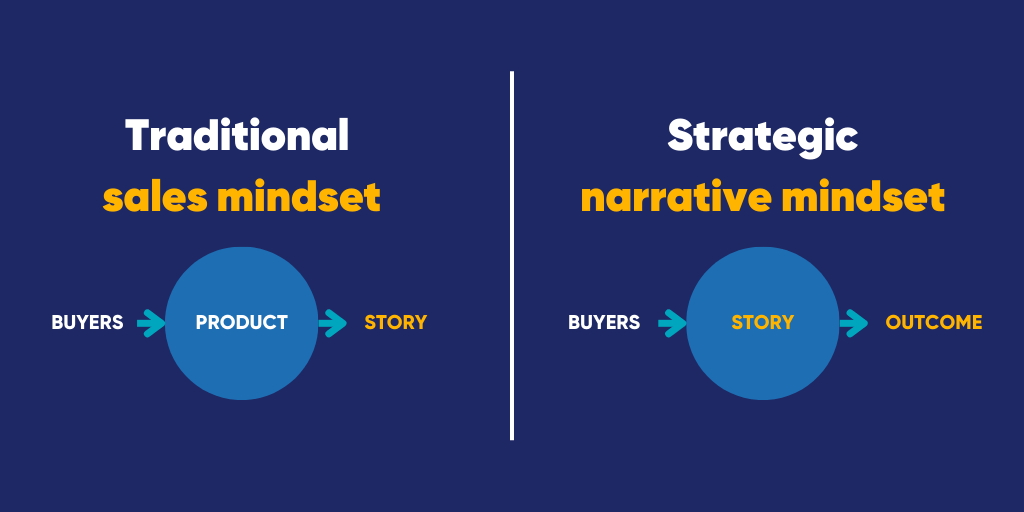Insight article

Reimagining sales: It’s time to walk in new shoes
Six steps to transform your sales team through storytelling
Business leaders are facing substantial pressure to deliver above-market growth at the best of times. However, when the global economy is in a weak state, the demands from shareholders become even more acute. Strategic mergers and acquisitions can generate some of this growth, but the fact remains that consistently beating the market requires strong organic sales growth.
Whilst most organisations have historically seen good sales performance, the stark reality is that buying behaviours have permanently changed and, as a result, so too has selling. In a recent survey by Korn Ferry, they found that 80% of salespeople feel their sales cycles have increased, while their average deal sizes have reduced. The primary reason is seen as corporate customers replacing their fear of missing out (FOMO) with fear of messing up (FOMU) due to recent social-economic events and adverse market conditions. In other words, where customers felt that if they missed out on the potential offered by new solutions, their business would lose out, the reverse is now true. Businesses are increasingly becoming risk averse – which is not good news for sellers.
Where our sales teams were always brilliant at selling product and service features, thriving in the future will mean we need to build more trust by adjusting our go-to-market and sales strategies to be outcomes-based. Our sales teams need to walk in new shoes, and big shoes at that. Requiring a critical new skill – storytelling. In the words of Steven Reinemund, CEO PepsiCo Inc., “To have growth in products, you have to have growth in people”.
74% of CSOs report they have recently or are currently updating their seller competency profiles for outcomes-based selling
According to Gartner, 74% of CSOs report they have recently or are currently updating their seller competency profiles for outcomes-based selling, and 61% of CSOs are already investing in new technology to enable virtual selling. This drive means a major paradigm shift for sellers, who not only need to build their ability to engage customers differently but must also be able to leverage new sales technologies.
Storytelling is at the heart of this and goes beyond merely presenting information; it involves crafting compelling narratives that resonate with customers, engage stakeholders, and drive success. It allows us to shift from a traditional sales mindset where we talk to our customers, define our differentiators and then build a story around it, to a strategic sales mindset where we talk to our customers, define our story around their situation and challenges, and then only bring the solution that will provide them with the best outcomes.
Let’s explore how your sales teams could step into your new shoes by leveraging storytelling – leading to remarkable results.
1. Aligning your teams and vision at an emotional level
Evolving your sales approach often requires significant changes in processes, strategies, and objectives. To achieve success, everyone involved needs to be on the same page. Storytelling serves as a unifying force, aligning sales teams and stakeholders around a shared vision. By narrating the story of the organisation’s journey, the challenges faced, and the desired future state, sales leaders can inspire their teams to embrace the transformation and work together towards a common goal.
2. Reimagining your customer engagements
When reviewing your go-to-market strategy, products or services may be repositioned or updated to meet changing customer needs. Similarly, shifting your customer engagements from transactional to conversational is critical. Arming your salesforce with storytelling allows them to not only articulate value propositions in a more compelling way, but also to build long-term relationships based on outcomes and value – driving loyalty and increased revenue. By presenting real-life examples of how the transformed offering has delivered tangible benefits to other customers, sales teams can create an emotional connection and instil confidence in your organisation’s value.
3. Creating a movement of change
Sales transformation often encounters resistance from sales representatives who are comfortable with existing ways of selling or sceptical about the changes. Storytelling can help address these concerns by sharing stories of successful transformations and the positive impact they have had on sales professionals’ careers. Stories of growth, achievement, and personal development can motivate sales teams to embrace the changes and see them as opportunities for growth rather than threats to their routine. Ensuring that your sales teams are emotionally connected to your unique story creates not only a willingness to change, but a powerful movement behind your change.
4. Building customer empathy
Effective selling requires understanding the customer’s needs and pain points. Storytelling can help sales professionals build empathy with customers by sharing stories of similar challenges faced by other clients and how the transformed solutions addressed those issues. By putting themselves in the customer’s shoes, sales teams can better anticipate and cater to their needs, fostering stronger customer relationships.
5. Differentiating in a crowded market
In competitive markets, customers are often presented with numerous choices. To stand out from the competition, sales teams must differentiate their offerings effectively. Storytelling provides a platform to create a unique selling proposition that goes beyond product features. By crafting narratives that emphasize your company’s values, mission, and impact, sales professionals can create an emotional connection with customers and differentiate their organisation in a crowded marketplace.
6. Generating customer advocacy
New sales motions not only impact the sales team but also influence your overall customer experience. Positive experiences lead to customer satisfaction and, ultimately, advocacy. Storytelling can drive customer advocacy by bringing your organisation and offerings to life in a manner through which your customer can “touch and feel” the value you will bring them. These stories serve to build long-term relationships based on outcomes – driving loyalty and increased revenue with powerful testimonials that potential customers can relate to, enhancing the organisation’s credibility and reputation.
It is undeniable that storytelling is an invaluable asset in the future of any sales team. By aligning teams and vision, communicating value propositions, overcoming resistance to change, building customer empathy, differentiating in a crowded market, and generating customer advocacy, storytelling empowers your sales professionals to connect with customers on a deeper level and drive success in the midst of transformation. As organisations continue to evolve and adapt, the ability to craft compelling narratives will remain a key driver in achieving sales excellence and sustaining long-term growth.
It is no longer just a nice to have, it has now become a business imperative if you want to step into your new shoes!




